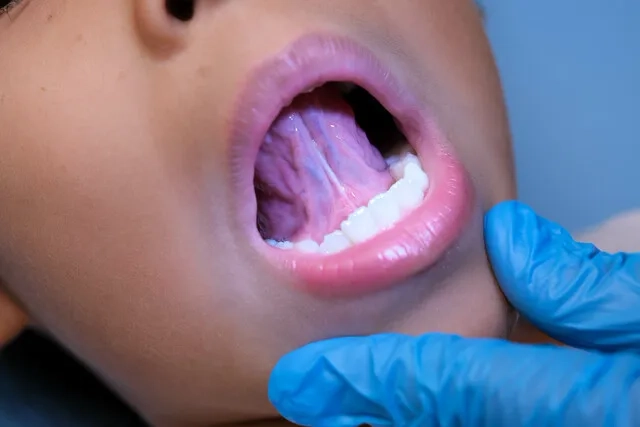The Benefits of Lip Tie Release Surgery for Infants and Children
In a world where the first smiles of our infants light up our lives, imagine if something as small as a thin piece of tissue could dim that light. This isn’t a tale from a far-off land but a reality for some children and their families. Lip tie, an often-overlooked condition, can cast a shadow over the early chapters of childhood, affecting feeding, speech, and dental health. Yet, the dawn of awareness brings hope through a procedure known as lip tie release surgery. Let’s embark on a journey to understand how this simple intervention can be a beacon of light for countless families, transforming challenges into triumphs.
The Hidden Hurdle: Understanding Lip Tie
Lip tie release surgery, a procedure increasingly recognized for its significant benefits in infants and children, addresses a condition that can be a hidden hurdle to successful breastfeeding and, subsequently, early childhood development. A lip tie occurs when the band of tissue that connects the upper lip to the gum is too tight, potentially restricting movement and affecting feeding, dental health, and speech development. For breastfeeding infants, a lip tie can cause difficulties in creating a proper latch, leading to inadequate nutrition and discomfort for both the infant and the breastfeeding parent. As children grow, a persistent lip tie may contribute to dental hygiene issues, as it complicates the effective cleaning of teeth, and can interfere with speech articulation.
The advantages of lip tie release surgery are profound, especially when performed with laser technology. This minimally invasive procedure offers a quick and precise correction of the lip tie, with minimal discomfort and a notably fast healing process. For infants, the immediate benefit is often seen in improved breastfeeding mechanics. A successful release can lead to a better latch, allowing for more effective feeding, which is crucial for infant nutrition and growth. This not only supports the physical health of the child but also fosters a stronger bonding experience during feeding times. Moreover, addressing a lip tie early can alleviate potential future dental issues and speech impediments, laying a foundation for healthier oral development.

Lip Tie Release Surgery
Understanding the implications of a lip tie is the first step toward recognizing the need for intervention. Lip tie release surgery stands out as a pivotal solution for mitigating its immediate and long-term complications. By improving feeding techniques, promoting better dental health, and preventing speech difficulties, this procedure offers a pathway to enhanced well-being for affected infants and children. The decision to pursue lip tie release surgery can have a lasting impact, underscoring the importance of early detection and consultation with healthcare professionals who can guide families through the process and toward a successful outcome.
Feeding Frustrations: The First Signpost
Feeding frustrations in infants can often be the first signpost indicating a lip tie, a condition that remains under-recognized yet significantly impacts a child’s early development. A lip tie occurs when the frenulum, the small fold of tissue connecting the upper lip to the gum, restricts lip movement due to its tightness or thickness. This restriction can lead to challenges in breastfeeding, as the infant may struggle to achieve a proper latch, resulting in a less effective suckling motion. For the breastfeeding parent, this can mean painful nursing sessions, decreased milk supply, and an emotionally taxing feeding experience. Moreover, the infant may exhibit signs of inadequate nutrition such as slow weight gain, increased irritability, and frequent feedings, which are distress signals that something is amiss in their ability to feed efficiently.
The benefits of addressing a lip tie through release surgery are multifaceted, primarily enhancing the feeding experience for both the infant and the breastfeeding parent. By correcting the lip tie, the surgery allows for greater mobility of the upper lip, facilitating a deeper and more secure latch. This improvement can lead to more efficient breastfeeds, ensuring the infant receives the necessary nutrition for healthy growth and development. The procedure, often quick and with minimal discomfort, can drastically reduce feeding frustrations, transforming it into a more positive bonding time between parent and child.
Recognizing feeding frustrations as a potential indicator of a lip tie is crucial for early intervention. Lip tie release surgery not only resolves immediate feeding issues but also prevents potential future complications related to speech, dental health, and overall well-being. It underscores the importance of vigilance and timely action by caregivers and healthcare professionals alike, aiming for a smoother, more fulfilling feeding journey and fostering optimal growth and development in infants and children.
Speech Delays: Navigating Through Muffled Waters
Lip tie release surgery for infants and children, particularly when addressing speech delays, stands as a beacon of hope for many families navigating through the muffled waters of communication barriers. A lip tie, characterized by an overly tight frenulum connecting the upper lip to the gum, can significantly hamper the movement necessary for clear speech articulation. This restriction not only affects feeding mechanisms but also has a profound impact on a child’s ability to produce certain sounds accurately, leading to potential speech delays and frustrations in verbal expression. By undergoing lip tie release surgery, the physical limitation is removed, thereby granting the child a clearer path toward developing robust speech capabilities.
The process of speech development is intricate, relying heavily on the ability of the tongue and lips to move freely and with precision. A lip tie can create an invisible hurdle, making it challenging for children to mimic the complex range of motions required for articulate speech. Following the surgical release of a lip tie, children often experience an improvement in their ability to form words and sounds correctly. This enhancement is pivotal, as clear speech is not only crucial for effective communication but also plays a significant role in social interactions and academic success. The surgery thus provides a critical intervention at a foundational stage in a child’s development, ensuring they do not fall behind in speech milestones.
Furthermore, the emotional and psychological benefits of lip tie release surgery extend beyond the immediate physical improvements. Children who struggle with speech delays due to a lip tie can experience frustration, decreased self-esteem, and social challenges. Addressing the root cause of these speech impediments early on liberates children from these barriers, allowing them to express themselves more freely and confidently. As they navigate through previously muffled waters with newfound clarity, the positive impacts of this surgery ripple through their overall well-being, highlighting the profound significance of timely intervention in the realm of speech development.

Lip Tie Release Surgery
Dental Dilemmas: Straightening the Path
Lip tie release surgery for infants and children offers a beacon of hope for resolving dental dilemmas that may arise due to the restricted movement of the upper lip. This condition, often unnoticed at birth, can pave the way for a series of dental challenges as the child grows. The tight band of tissue, if left untreated, can hinder proper oral hygiene practices, making it difficult to clean the teeth and gums effectively. This can lead to an increased risk of tooth decay and gum disease. Furthermore, a lip tie can affect the spacing and alignment of teeth, potentially necessitating orthodontic treatment in later years. By opting for lip tie release surgery, parents can straighten the path towards better dental health for their children, mitigating these risks early on.
The procedure itself, particularly when performed with laser technology, offers precision and minimal discomfort, making it a favorable option for young patients. The benefits extend beyond immediate dental health improvements; the surgery facilitates easier access to the back of the mouth and the spaces between teeth for cleaning, thereby promoting better oral hygiene habits from a young age. This proactive approach can significantly reduce the likelihood of dental issues developing, providing a solid foundation for a lifetime of healthy smiles. Additionally, correcting a lip tie early can help ensure that a child’s teeth grow in more aligned, potentially reducing the need for extensive orthodontic work in the future.
Beyond the tangible dental health benefits, lip tie release surgery also plays a crucial role in enhancing a child’s overall well-being. Improved oral hygiene and dental alignment contribute to higher self-esteem and confidence, particularly as children become more conscious of their appearance among peers. By addressing this condition early, parents can help ensure not only the dental health of their child but also support their social and emotional development. This intervention, therefore, represents a holistic approach to tackling the multifaceted impact of lip ties on a child’s life, straightening the path not only for their dental journey but for their broader journey through childhood and beyond.
The Procedure: A Beacon of Hope
Lip tie release surgery has emerged as a beacon of hope for many families grappling with the challenges posed by a lip tie in their infants and children. This condition, characterized by an overly tight or thick band of tissue connecting the upper lip to the gum, can significantly impede feeding, speech development, and dental health. The procedure, often performed using advanced laser technology, precisely targets and releases the restrictive frenulum, thereby allowing for greater mobility of the upper lip. This minimally invasive approach ensures a quick and relatively pain-free experience for the young patient, with most reporting only minor discomfort during the healing process. The immediate benefits observed post-surgery, particularly in feeding efficiency and comfort, underscore the procedure’s vital role in addressing the complications associated with lip ties.
The positive outcomes of lip tie-release surgery extend beyond the physical relief it provides. For breastfeeding mothers, the improvement in latch and feeding can alleviate the physical discomfort and emotional stress often associated with nursing a child with a lip tie. This enhancement in the feeding experience fosters a stronger bond between mother and child, promoting a sense of well-being and confidence in the mother’s ability to nourish her infant effectively. Furthermore, the surgery lays a foundation for healthier oral development, reducing the likelihood of future dental issues and facilitating clearer speech articulation as the child grows.
Acknowledging the significance of lip tie release surgery in the lives of affected infants and children illuminates its status as a beacon of hope. By offering a solution that addresses both immediate and long-term challenges, the procedure empowers families to navigate the complexities of lip ties with optimism. It underscores the importance of early detection and intervention, ensuring that children have the opportunity to thrive without the constraints of a lip tie hindering their development. As awareness of this condition and its treatment options continues to grow, more families are finding the support and solutions they need to overcome the hurdles presented by lip ties.

Lip Tie Release Surgery
Beyond the Operation: Sailing into Brighter Horizons
Lip tie release surgery marks the beginning of a transformative journey for infants and children, steering them towards brighter horizons in their developmental voyage. Beyond the operation itself lies a realm of enhanced opportunities for growth and well-being. This procedure, aimed at correcting the restrictive frenulum that limits the movement of the upper lip, sets the stage for improved feeding capabilities, speech development, and dental health. The immediate aftermath of the surgery often reveals a significant improvement in breastfeeding efficiency, as infants can latch more effectively, ensuring optimal nutrition and fostering a stronger bond between mother and child. This pivotal moment can alleviate the stress and discomfort previously experienced during feedings, replacing it with a sense of relief and joy.
As children sail beyond the initial benefits of the operation, the long-term advantages come into clearer view. Correcting a lip tie early in life can preemptively address potential speech impediments, allowing for clearer articulation and confidence in verbal expression. This foundational aspect of communication is crucial for social interactions and academic success, underscoring the far-reaching impact of the surgery. Furthermore, the removal of barriers to proper oral hygiene paves the way for healthier dental outcomes, reducing the risk of tooth decay and gum disease that could complicate a child’s journey into adolescence and beyond.
Embarking on the path of lip tie release surgery enables families to navigate past the choppy waters of developmental challenges, setting sail toward a future filled with promise. The procedure not only resolves immediate physical hurdles but also opens up a spectrum of possibilities for children to thrive in all facets of their growth. By investing in this corrective intervention, parents provide their children with the key to unlock their full potential, ensuring that the obstacles once posed by a lip tie become a distant memory. In this way, the journey beyond the operation is one of hope, health, and happiness, charting a course toward a bright and flourishing future.
Conclusion
The journey through understanding and addressing lip tie is akin to navigating through foggy waters towards a sunrise of possibilities. Lip tie release surgery stands as a lighthouse, guiding families to shores of relief and happiness. It’s more than just a medical procedure; it’s a key that unlocks potential, allowing infants and children to feed efficiently, speak clearly, and smile brightly. As awareness grows, so does the number of families embarking on this transformative journey, turning challenges into victories. In the realm of pediatric health, the liberation from lip ties is a testament to the power of knowledge and the relentless pursuit of well-being, ensuring that every child’s smile shines as brightly as it was meant to.
Evergreen Pediatric Dentistry
https://www.google.com/maps?cid=14720788683151219551
12910 Totem Lake Blvd NE #103, Kirkland, WA 98034, United States
(425) 814-3196
https://evergreenkidsdentist.com/


